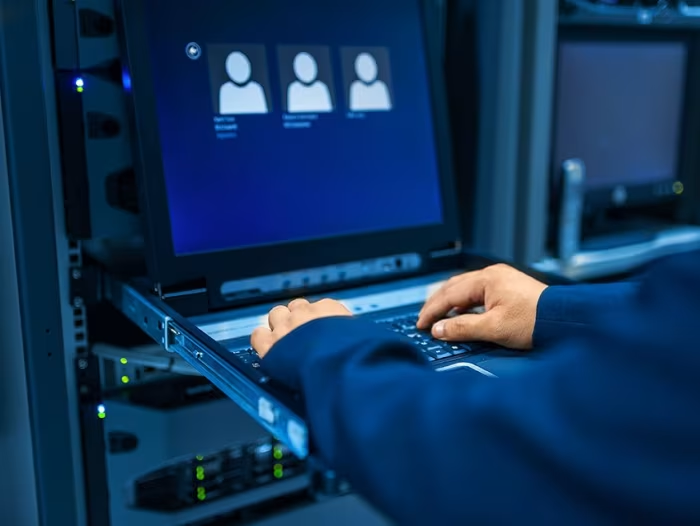Resource / Online Journal
What is the Difference Between Authentication and Authorization?
Understand the key differences between authentication and authorization, explore how organizations can benefit from implementing both effectively, and discover how TechDemocracy can support you with tailored authentication and authorization solutions.
Published on Jul 11, 2025

What Is Authentication?
Authentication is the process of verifying that a user, device, or service is genuinely who or what it claims to be. Before any access is granted to a system or resource, authentication acts as the first line of defense, ensuring that only legitimate entities are allowed in.
This verification typically involves credentials such as passwords, biometric data, or cryptographic tokens. Whether you're logging into a secure network or accessing a cloud-based application, authentication is the gatekeeper that confirms your identity.
It’s important to distinguish authentication and authorization; while authentication answers the question, “Are you who you say you are?” authorization asks, “Are you allowed to do what you’re trying to do?” These processes often occur in sequence, but they serve fundamentally different purposes.
Authorization policies define what should be allowed. Access control mechanisms enforce those policies in real time.
What Is Authorization?
Authorization is a key function of Identity and Access Management (IAM), operating based on predefined policies. It determines whether a system, user, or application has the predefined permissions to access/view a specific resource or perform a particular action. This includes permissions such as reading a file, modifying a record, executing a command, or accessing a service.
Example: A user in the finance department may be authorized to view budget reports but not modify payroll data.
Authorization applies not only to human users but also to software agents and hardware systems interacting with protected resources.
Authentication vs. Authorization
Although closely related, authentication and authorization serve distinct roles in a security framework. Authentication confirms identity. Authorization defines permissions. One cannot substitute for the other, but both are essential for secure access control. They are often implemented together, but address different questions:
Authentication | Authorization |
|---|---|
| Authentication verifies identity | Authorization determines access rights |
| Authentication always comes first | Authorization follows after successful authentication |
| Authentication is about identity management | Authorization is about access management |
| Authentication requires active input from the user | Authorization is typically automatic, based on predefined rules |
| Authentication tools: Passwords, OTPs, biometrics, SSO | Authorization tools: RBAC, ABAC, ACLs, policy engines |
Example: An employee enters their company email and password to log into the internal HR portal. This step confirms the employee's identity. | Example: Once logged in, the employee can view their own payslip but cannot access payroll data for other employees. This restriction is based on their role and permissions. |
Role of Authorization in Access Control
Authorization is a key element of access control systems, establishing the policies that determine who can access specific resources. These policies specify what actions are allowed for different users. Access control mechanisms enforce these policies in real time.
Once a user is authenticated, authorization mechanisms determine whether their access request aligns with the system’s rules. Common authorization models include
1. Access Control Lists (ACLs)
Access Control Lists (ACLs) are structured lists that define which users or groups can access specific resources and what operations, such as read, write, or execute, they are permitted to perform.
Key Points:
- Each entry in an ACL specifies a subject (user or group) and the allowed actions.
- ACLs are widely implemented across file systems and network resources to enforce granular access control.
- They provide a straightforward mechanism for managing permissions on individual objects.
2. Role-Based Access Control (RBAC)
RBAC assigns permissions to users based on their roles within an organization (e.g., admin, editor, viewer).
Key Points:
- Users are given roles, and each role comes with a set of permissions attached to it.
- Supports principles like least privilege and separation of duties.
3. Attribute-Based Access Control (ABAC)
ABAC evaluates access requests based on dynamic attributes such as user department, location, time, and other environmental or contextual factors.
Key Points:
- Policies are defined using attributes of users, resources, actions, and environment.
- Enables fine-grained, context-aware access decisions.
4. Policy Enforcement Points (PEPs)
PEPs are components in an access control architecture that enforce access decisions, typically by interacting with a Policy Decision Point (PDP) and using standards like XACML.
Key Points:
- PEPs act as the gatekeepers, allowing or denying access based on policy evaluation results.
- Common in systems implementing XACML for policy-based authorization.
Why Authentication and Authorization Strategy Is Essential
Authentication and authorization work in tandem to ensure that only verified users gain access to systems and that each user can only interact with resources appropriate to their role or permissions.
Protects Against Credential Theft: Implementing strong authentication methods, especially Multi-Factor Authentication (MFA), significantly reduces the risk of account compromise due to stolen or weak credentials.
Reduces Risk of Unauthorized Access: By requiring multiple forms of verification, such as something you know (password), something you have (token), and something you are (biometric), organizations can better safeguard sensitive systems and data.
Supports Compliance: Regulatory frameworks like HIPAA, PCI-DSS, and SOC 2 mandate strong authentication practices to protect sensitive information and maintain legal compliance.
Benefits of Combining Authentication and Authorization
Layered Security: Authentication verifies identity, while authorization ensures that authenticated users only access what they’re permitted to. Together, they form a multi-layered defense against both external and internal threats.
Principle of Least Privilege: This approach ensures users have only the access necessary for their roles, minimizing the impact of compromised accounts or insider threats.
Auditability and Control: Integrated systems provide clear audit trails, making it easier to monitor access, detect anomalies, and investigate incidents.
Flexibility and Scalability: Separating and combining these processes allows organizations to adapt policies and methods independently, supporting evolving security needs without disrupting operations.
Impact on Organizational Security
Mitigates Identity-Based Attacks: The rise of identity-based attacks is concerning; therefore, implementing strong authentication measures and granular authorization is essential to prevent attackers from taking advantage of stolen credentials or escalating their privileges.
Protects Sensitive Information: These controls are designed to safeguard confidential data, intellectual property, and critical infrastructure from unauthorized access.
Supports Regulatory Compliance: Effective strategies are often required for compliance with data protection laws and industry standards, reducing legal and financial risks.
Enhances Trust and Reputation: Demonstrating robust access controls reassures customers, partners, and regulators that the organization takes security seriously, protecting its brand, reputation, and business relationships.
Conclusion
Authentication and authorization ensure that only verified users gain access, and only to the resources they’re permitted to use, protecting sensitive data, reducing risk, and supporting compliance.
To strengthen your organization’s identity and access strategy, partner with TechDemocracy, a trusted cybersecurity solutions provider. Through secure, passwordless authentication and intelligent access control, we help enterprises build user-friendly, scalable, and cost-effective security frameworks.
Recommended articles


The Role-Based Access Control (RBAC)
Take Your Identity Strategy
to the Next Level
Strengthen your organization's digital identity for a secure and worry-free tomorrow. Kickstart the journey with a complimentary consultation to explore personalized solutions.